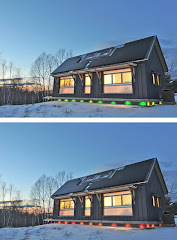
As we try to decrease the carbon footprint of our buildings, we need to consider two distinct, but inter-related issues: reducing the carbon footprint of the building process itself, and reducing the carbon footprint of running and maintaining the structure once built.
Addressing the second issue led us to choose super-insulation (to minimize the energy required to heat the place) and sustainable energy sources such as solar thermal and photovoltaics.
Here I want to say just a few words about the other issue, minimizing the carbon emissions resulting from the building process itself.
First of all, this is to my mind a much harder problem to solve than that of reducing the carbon impact of ongoing energy use. Ongoing energy needs can be straightforwardly addressed by judicious design (to decrease consumption by eliminating waste) and switching to zero-emission sources of energy such as wind or solar. To solve the problem of reducing the impact of the building process itself, we need to consider the carbon load introduced by making, transporting, and assembling each and every component of the building. This calculation quickly becomes extremely complex, requiring detailed knowledge of materials, manufacturing processes, and modes of transport.
To take a simple example: the chemical process by which cement powder is turned into hardened concrete (just add water and stir!) releases CO2 - lots and lots of it, it turns out. So we have tried to use more wood and less concrete, even though concrete has many desirable properties as a building material (easy to shape, high thermal mass). But if the wood is harvested in Indonesia (as much wood is) and transported to us by boat, train, and truck, we have incurred the carbon load of all that transport. So we have tried to minimize transport by local sourcing of wood, to the extent feasible. And on and on.
The underlying concept here is generally called embodied energy: each structure embodies all of the energy (and associated carbon emissions) used to make its constituent parts, transport them to the site, and assemble them into the finished building. On the BrightBuilt team, we usually call it the carbon debt we have incurred by building a structure where there wasn't one, or the kilowatt hole we have to dig out of by generating zero-emission electricity that displaces high-carbon fossil fuel use.
It turns out that there is no central database containing data on the embodied energy of common building materials. Worse, there is no single, widely accepted method for calculating embodied energy.
We have consulted experts around the globe, from MIT to Australia, in an attempt to calculate the embodied energy of BrightBuilt Barn. While we believe that we have made a serious and intellectually honest attempt, we do not claim to have precise and unassailable results.
Brian, of Opus One Studio, has become our resident expert on the subject. In a future post, he will give some of his findings and methods.
For now, we will only say that the carbon debt incurred by even a small building such as BrightBuilt barn is surprisingly high, and will require years of excess clean energy production to pay back. We are helped here by 1) our commitment to durable materials, which greatly lengthen the usable life of the building, and so give us a longer time frame over which to amortize the carbon debt; and 2) our decision to maximize the excess energy we produce, by using superinsulation to reduce energy demand while covering the roof with solar energy systems despite the reduced need for ongoing energy.
Brian's Energy Meter will track the energy surplus, both minute-to-minute and cumulative, and we will put the results on the web at the BBB site, so anyone can track the progress we make in climbing out of our "kilowatt hole."













No comments:
Post a Comment